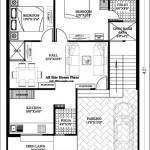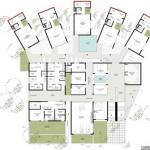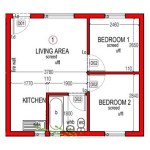How To Draw A Room Plan For Free
Creating a room plan, often referred to as a floor plan, is a crucial initial step in any interior design, renovation, or space planning project. A well-executed room plan provides a visual representation of the space, allowing for experimentation with furniture arrangement, assessing spatial relationships, and identifying potential challenges before any physical alterations are made. While professional software options exist, drawing a room plan for free is entirely achievable using various accessible methods and tools.
This article will delineate several approaches to creating free room plans, encompassing both traditional hand-drawn techniques and digital applications. It will explore the necessary steps, tools, and considerations involved in producing accurate and functional room plans without incurring any financial cost.
I. Essential Tools and Preparation
Before commencing the drafting process, gathering the necessary tools and making accurate measurements is paramount. Whether opting for a manual or digital approach, having the right equipment will significantly improve the accuracy and overall quality of the room plan.
For a hand-drawn plan, the following items are recommended:
*Measuring Tape:
A retractable measuring tape, preferably one that extends to at least 25 feet, is essential for accurately measuring the dimensions of the room. Laser measuring tools can also be used for accuracy and convenience. *Graph Paper:
Graph paper provides a scaled grid, facilitating the proportional representation of the room and its features. A standard grid size of 1/4 inch is generally suitable. *Pencil and Eraser:
Using a pencil allows for easy corrections and adjustments during the drafting process. A good quality eraser is equally important for clean revisions. *Ruler or Straightedge:
A ruler or straightedge ensures that all lines are drawn straight and accurately, contributing to a professional-looking plan. *Notebook:
Keeping a notebook to record measurements, notes, and observations is crucial for maintaining accuracy and organization throughout the process.For a digital plan, the tool requirements differ:
*Computer or Tablet:
A computer or tablet is needed to run the chosen free room planning software or web application. *Web Browser:
If using a web-based application, a reliable internet connection and a compatible web browser are necessary. *Mouse or Stylus:
A mouse is adequate for basic drawing, but a stylus, especially when using a tablet, will provide greater precision and control. *Measuring Tape:
Similar to the hand-drawn approach, a measuring tape is still needed to collect the initial room dimensions and features.Once the tools are prepared, the next crucial step is taking accurate measurements of the room. This includes:
*Wall Lengths:
Measure the length of each wall at floor level, ensuring that the tape measure is held taut and straight. Record all measurements in the notebook. *Door and Window Dimensions:
Measure the width and height of all doors and windows, including the distance from the floor to the bottom of the window (sill height). *Fixed Features:
Note the location and dimensions of any fixed features, such as fireplaces, radiators, built-in shelves, or electrical outlets. Indicate their position relative to the walls. *Ceiling Height:
Measure the ceiling height at several points in the room to account for any variations. *Obstructions:
Identify and measure any architectural obstructions, such as columns, pipes, or angled walls.It is beneficial to create a rough sketch of the room on paper while taking measurements. This sketch will serve as a visual reference and help ensure that all dimensions are accounted for.
II. Creating a Hand-Drawn Room Plan
Producing a hand-drawn room plan offers a traditional and tactile approach to space planning. It allows for a direct connection with the design process and can be particularly useful for individuals who prefer a hands-on method.
The process involves the following steps:
*Establishing Scale:
Determine an appropriate scale for the plan. For example, 1/4 inch on the graph paper could represent 1 foot in the actual room. Record the chosen scale clearly on the plan. *Drawing Exterior Walls:
Using the measured wall lengths and the established scale, draw the exterior walls of the room on the graph paper. Ensure that the lines are straight and accurately represent the room's shape. *Adding Interior Walls:
Draw any interior walls, maintaining the correct length and position relative to the exterior walls. Pay close attention to the thickness of the walls, which should be drawn proportionally to the scale. *Representing Doors and Windows:
Indicate the location of doors and windows by drawing openings in the walls. Represent the door swing using a curved line, indicating the direction in which the door opens. Use appropriate symbols for windows. *Adding Fixed Features:
Draw in any fixed features, such as fireplaces, radiators, or built-in shelves. Accurately position them based on the measurements taken. *Labeling Dimensions:
Label each wall, door, window, and fixed feature with its corresponding dimensions. Use clear and legible handwriting. *Adding Furniture (Optional):
Furniture can be represented using simple shapes drawn to scale. This helps visualize how furniture will fit within the space.While a hand-drawn plan is straightforward, achieving accuracy requires meticulous attention to detail and consistent use of the established scale. It may be necessary to redraw sections if errors are identified.
III. Utilizing Free Online Room Planning Tools
Numerous free online room planning tools are available, offering a convenient and user-friendly alternative to hand-drawn plans. These tools provide a digital interface for creating and manipulating room plans, often with features such as drag-and-drop furniture, 3D visualization, and automatic dimensioning.
Several popular free online room planning tools include:
*Planner 5D:
Planner 5D offers both 2D and 3D design capabilities, allowing users to create detailed room plans and visualize the space in a realistic manner. It features a comprehensive library of furniture and décor items. While the platform offers premium features, its basic functionality is accessible for free. *RoomSketcher:
RoomSketcher provides a user-friendly interface for drawing room plans and furnishing them with a variety of objects. The free version allows users to create one project with limited features. Higher tiers require subscriptions. *Sweet Home 3D:
Sweet Home 3D is a free, open-source interior design application that can be downloaded and installed on a computer. It offers both 2D and 3D views, a wide range of furniture models, and the ability to import custom models. *Floorplanner:
Floorplanner allows users to create detailed 2D and 3D floor plans with ease. The free version offers limited projects and features. *Homestyler:
Homestyler is another free option offering 2D and 3D rendering capabilities. It possesses a large catalog of furniture and appliances from real brands, allowing realistic visualization of a space.The general process of using these online tools involves the following steps:
*Creating an Account:
Most online tools require users to create a free account to save their projects. *Selecting a Template or Starting from Scratch:
Some tools offer pre-designed templates for common room shapes, while others allow users to start with a blank canvas. *Drawing Walls:
Use the drawing tools to create the walls of the room, entering the measured dimensions. Ensure that the dimensions are accurate. *Adding Doors and Windows:
Drag and drop doors and windows from the object library and position them in the walls. Adjust their size and placement as needed. *Adding Fixed Features:
Insert fixed features, such as fireplaces or radiators, from the object library. *Adding Furniture (Optional):
Drag and drop furniture items from the library to arrange them in the room. Most tools allow furniture to be resized and rotated. *Labeling Dimensions:
Use the dimensioning tools to label the lengths of walls, doors, windows, and furniture. *Viewing in 3D:
Most tools offer a 3D view, allowing users to visualize the room in a realistic manner.The primary advantage of using online room planning tools is their ease of use and the ability to create detailed and visually appealing plans. However, the free versions of these tools often have limitations in terms of features and the number of projects that can be saved.
IV. Considerations for Accuracy and Functionality
Regardless of the chosen method, accuracy and functionality are crucial considerations when creating a room plan. A poorly executed plan can lead to inaccurate estimations, incorrect furniture purchases, and ultimately, a less than ideal space.
To ensure accuracy:
*Double-Check Measurements:
Before starting the drafting process, double-check all measurements to minimize errors. *Use a Consistent Scale:
Maintain a consistent scale throughout the plan to ensure that all elements are proportionally correct. *Pay Attention to Detail:
Pay close attention to the placement of doors, windows, and fixed features, ensuring that they are accurately positioned. *Utilize Grids:
If using graph paper, utilize the grid lines to maintain straight lines and proportional accuracy. *Review the Plan:
Once the plan is complete, carefully review it for any errors or inconsistencies.To ensure functionality:
*Consider Circulation:
When arranging furniture, consider the flow of traffic through the room. Ensure that there is adequate space for movement. *Account for Door Swings:
Ensure that door swings do not obstruct pathways or interfere with furniture placement. *Consider Electrical Outlets:
Note the location of electrical outlets and ensure that furniture is positioned in a way that allows easy access to them. *Visualize the Space:
Visualize the space in 3D (either mentally or using a 3D tool) to gain a better understanding of how the room will feel. *Experiment with Different Layouts:
Try out different furniture layouts to find the optimal arrangement for the space.By paying attention to these considerations, it is possible to create a room plan that is both accurate and functional, regardless of whether it is drawn by hand or using a free online tool.
:max_bytes(150000):strip_icc()/plan-your-room-579be53f5f9b589aa9883da4.png?strip=all)
The Best Free Room Layout Planners

Draw Floor Plans With The Roomsketcher App

Best Free Room Planner Tools

Floor Plan Creator And Designer Free Easy App

Room Layout Planner Design

Floor Plan Creator Planner 5d

Floor Plans Learn How To Design And Plan

Room Layout Planner Design

Draw A Room From The Floor Plan Medibang Paint Free Digital Painting And Manga Creation

Floor Plan Creator Planner 5d








